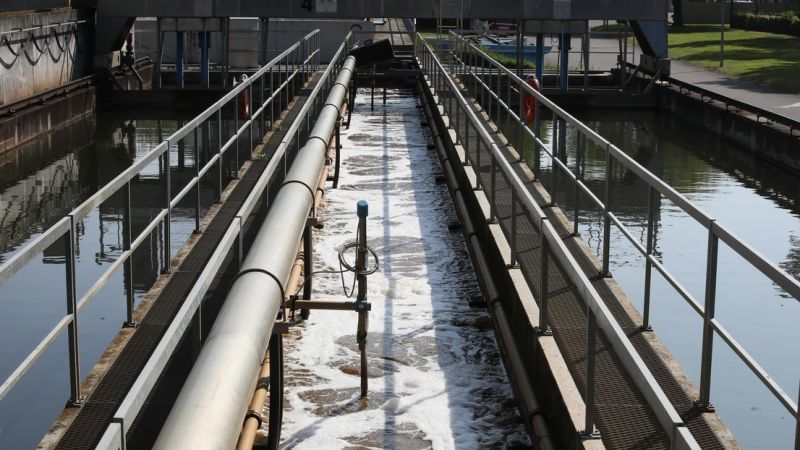Turning Wastewater Sludge into Energy and Mineral Salts (Video)
Published on by Water Network Research, Official research team of The Water Network in Technology
A system developed by EPFL spin-off TreaTech can turn sludge from wastewater treatment plants into mineral salts – which could be used in fertilizer, for example – and biogas. The firm’s research is being funded by several private- and public-sector entities, and a large-scale pilot plant is now being built. The system is scheduled to be installed at a wastewater treatment plant in 2022.

Wastewater treatment plants produce an effluent commonly known as sludge. Plant operators previously disposed of this sludge directly as fertilizer, but that was made illegal in Switzerland a little over ten years ago due to the growing concentration of pollutants found in effluents. As a result, the sludge is usually dried into cakes and burned, taking thousands of tons of phosphorus with it every year.
That matters because phosphorus is an essential compound in several biological processes, including photosynthesis, but there was no feasible method for recycling the phosphorus in effluent streams until now. Engineers at EPFL’s Laboratory of Sustainable and Catalytic Processing have designed a system capable of recovering the phosphorus, the market for which is estimated at CHF 33 billion. The system was developed by TreaTech, a company spun off from the lab. TreaTech’s system can also produce biogas from the effluent thanks to technology, called thermal gasification, developed at the Paul Scherrer Institute.
To reduce transportation costs, the sludge which is 95% water is first dehydrated by wastewater plants, requiring in-turn a great deal of energy that has a cost of its own. The residue is then incinerated else where. “Our system can recover sludge directly from wastewater treatment plants without any drying or other preliminary processing needed,” says Frédéric Juillard, CEO of TreaTech. In his system, the effluent stream is fed into a high-pressure, high-temperature separator (> 22.1 MPa and 400°C) where the fluid enters a supercritical state (i.e., between liquid and gas). That sharply lowers the solubility of the phosphorus and mineral salts in the fluid, causing them to crystallize into solids that can be easily recovered. “Over 90% of phosphorous can be recuperated,” underlines the CEO.
Converting nearly 100% of organic matter into biogas
Some wastewater treatment plants already have systems for recycling sludge into biogas. “But biodigesters they currently use can convert only 40–50% of the organic matter,” says Gaël Peng, co-founder and CTO of TreaTech. The remaining digestate is dried and transported to incineration facilities. That generates substantial costs and requires a lot of energy. “Sludge processing and disposal account for around 40% of a wastewater treatment plant’s total operating costs,” adds Peng. Juillard therefore wanted to incorporate technology for generating biogas into his system, in order to help plant operators lower costs and boost conversion rates.
He spent several months studying different technologies being developed around the world, but found the solution less than 200 km from EPFL, at the Paul Scherrer Institute. Scientists there were working on a new kind of reactor that uses ruthenium as the catalyst and that can achieve a nearly 100% conversion rate into biogas that can be used to produce heat or electricity, or even as biofuel. The resulting water is devoid of toxicity and can be pumped directly back into municipal water systems.
What’s more, the scientists’ technology also saves a considerable amount of time – their reactors can turn sludge into biogas in just 20 minutes, whereas existing biodigesters need around 30 days. That can also save space at wastewater treatment plants and leaves no waste.
Large-scale testing
TreaTech’s research is being supported by the Paul Scherrer Institute as well as the Swiss Federal Office of Energy. The company has successfully tested a prototype and is now building a large-scale version. It plans to install its system at a wastewater treatment plant in 2022 – just in time to help plant operators comply with new phosphorus recycling regulations that could go into effect in Switzerland in 2026. By requiring companies to recycle phosphorus, the Swiss government hopes to avoid the costs and environmental risks of importing the chemical.
Now that TreaTech has successfully tested its prototype, it is building a pilot plant that is 100 times bigger and can treat 100 kg/h of sludge. The firm’s research is being supported by the Swiss Federal Office of Energy and obtained CHF 4.4 million in funding from a public-private partnership. The pilot plant should be completed by the end of the year, and the system is scheduled to be installed at a wastewater treatment plant in 2022, with the capacity to process 3 metric tons of sludge per hour.
The next step will be to adapt the system for use in other applications, such as for treating industrial wastewater, wastewater from desalination plants or biomass residue.
Attached link
http://www.youtube.com/embed/UNgDafL9UTgMedia
Taxonomy
- Fertilizers
- Sludge Separation
- Industrial Wastewater Treatment
- Sludge Treatment
- Sludge Management
- Wastewater Treatment
- Biogeochemistry
- Wastewater Treatment Plant Design
- Biogas
- Sludge Treatment & Management